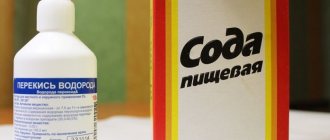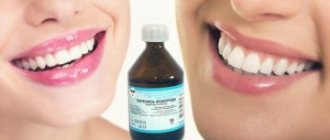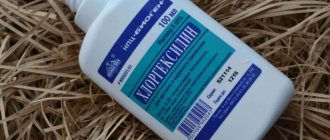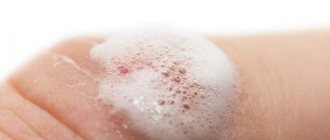Hydrogen peroxide is a substance that modern people always have at hand, because it is used in medicine and in everyday life, in clinics and at home. Recently, many useful tips have appeared on the use of this drug for rinsing the mouth for the purpose of disinfection, gum treatment and teeth whitening. But any medicine has contraindications and negative effects, so first you should figure out whether it is possible to rinse your mouth with hydrogen peroxide and how it should be diluted.
Is it possible to rinse teeth and gums with hydrogen peroxide?
You can rinse your mouth with hydrogen peroxide without harm to your teeth and body, but only with a solution with a concentration of no more than 3%. When rinsing your mouth with this liquid, several effects occur simultaneously:
Disinfection of the oral cavity.- Acceleration of healing of wounds and inflamed mucous membranes.
- Drying of the mucous membrane.
- Enamel whitening.
- Stopping minor bleeding.
- Cleansing the oral cavity from crusts, scabs, remnants of blood clots after injuries and operations.
This complex effect has led to the widespread use of this product in dentistry. Dentists prescribe peroxide rinses for the following conditions:
- Oral infections – stomatitis, candidiasis.
- Inflammatory processes - gingivitis, periodontitis, periodontal disease.
- Bleeding gums.
- Presence of dark spots on the enamel.
- The presence of bad breath is halitosis.
The product is used in the treatment of sore throat, otitis media and runny nose, as well as when lips become inflamed due to herpes. To do this, take a diluted solution, but it can only be used after consultation with the attending physician.
Why you need to rinse the wound
Open wound after tooth extraction
This is a tasty morsel for the proliferation of pathogenic bacteria.
There are a lot of them in the mouth, as they accumulate near stuck pieces of food and plaque. If the gums are not protected, bacteria can provoke an inflammatory process
, suppuration and swelling of the soft tissues in the wound area, and cause pain. It is better not to disturb the wound for a day after the operation, so that a blood clot can form and the bleeding stops. Then you need to start rinsing to protect the postoperative site from bacteria and speed up wound healing. Let's figure out what to rinse with.
Cautions when rinsing teeth with hydrogen peroxide
To many, hydrogen peroxide seems like the most harmless antiseptic, but it has many contraindications and requires caution when used. The drug should not be used:
- For severe bleeding gums in patients with periodontitis.
- If there are a large number of fillings.
- Patients with a thin layer of enamel and caries.
- During pregnancy and lactation, due to the possible consequences of rinsing the mouth with hydrogen peroxide, not only for the mother, but also for the baby.
- For the treatment of children under 12 years of age. Children may rinse incorrectly and swallow the product. In addition, they are more sensitive to the unpleasant taste of the drug, which may cause them to vomit.
- During antibiotic treatment.
Hydrogen peroxide should not be taken orally. A solution with a concentration of more than 3% should not be used even for rinsing the mouth; it should be diluted.
Hydrogen peroxide must not only be used correctly, but also stored with precautions. A bottle of peroxide solution, perhydrol or hydroperite tablets - other pharmacological forms of this drug - should not be left in places accessible to children. Poisoning with this drug can be fatal. It is better to store the drug in a closed cabinet in a room where there is no strong increase in air temperature, otherwise it will lose its properties.
What is hydrogen peroxide
Hydrogen peroxide is a clear liquid. It has a characteristic metallic taste. This, by the way, comes as an unpleasant surprise for many when it comes to rinsing solution. Peroxide is highly soluble in water, ether or alcohol. But a more concentrated aqueous solution can even be explosive. Hydrogen peroxide is often used as a solvent because it dissolves other substances well.
We are used to a liquid three percent solution of hydrogen peroxide. But its concentrate looks different. Liquid hydrogen peroxide in concentrated form has a high degree of viscosity. It is significantly different from the solution that is in our first aid kit. It is significantly heavier than water (almost one and a half times). It is generally very different from water. To make it boil, you will need to heat H2O2 to 150 degrees. If pure hydrogen peroxide gets on the skin, it will immediately cause a severe chemical burn. In this case, the person will feel a sharp burning pain, and a white mark will remain on the skin.
If H2O2 is heated, oxygen can also be obtained. The same effect will occur when exposed to ultraviolet radiation or silver ions or transition metals. Hydrogen peroxide also exhibits weak acid properties. It is a strong oxidizing agent. It also has restorative properties.
If we talk about the biological properties of hydrogen peroxide, then if it is formed in excess quantities in the cell, then oxidative stress is observed. This is an excellent bactericidal agent. True, the mammal’s body is not able to reduce oxygen to hydrogen peroxide. He does not have the necessary enzymes for this.
How to properly prepare the solution and rinse your mouth
Before you rinse your mouth with hydrogen peroxide, you need to dilute it. It is recommended to take a tablespoon of hydrogen peroxide per glass of water. The solution should not be hot, but not cold either. Rinsing begins only after thoroughly brushing your teeth and rinsing the mouth with clean water; such manipulations will prevent unwanted chemical reactions between the components of the drug and the toothpaste.
The peroxide solution should not be kept in the mouth for too long; it is recommended to carry out the procedure for no longer than 10 minutes. During this time, you should periodically spit out the liquid and put a fresh portion into your mouth. After the procedure is completed, the product is spat out so that it does not remain in the mouth or enter the digestive system.
If the rules of rinsing are violated, nausea and vomiting may occur; in severe cases, burns of the digestive organs may occur. If you feel a strong burning sensation during the procedure, especially if there are ulcers on the oral mucosa, you should stop rinsing and rinse your mouth with clean water.
How to rinse your mouth after tooth extraction
It would seem that if there is a tooth, there are problems; if there is no tooth, there are no problems. However, after tooth extraction
The problems may just begin in the surgery room.
After all, as a consequence of the operation, a wound remains, which can heal calmly, or it can hurt, ooze blood, become inflamed and even fester. How to behave correctly to avoid problems? The wound needs to be rinsed with special products
and
medicinal baths
. However, hygiene procedures must be performed correctly. If the dentist did not tell you about it in detail, we will tell you.
Can peroxide be used to whiten teeth?
Hydrogen peroxide can be used to whiten tooth enamel only if there are no contraindications. To make sure that the enamel layer is strong enough and not too thin, it is better to visit a dentist and consult with him about the possibility of using this product.
The following whitening methods are known:
- They take a mixture of hydrogen peroxide and soda, sometimes diluted with eucalyptus oil. The paste is applied to a toothbrush. After brushing your teeth, you need to rinse your mouth. Food can be taken no earlier than 20 minutes after the procedure.
- Three drops of the product are placed on toothpaste; it is recommended to use toothpaste for the treatment of periodontal disease.
- If there is a limited stain on the enamel, you can clean it with a cotton swab dipped in hydrogen peroxide. But first you need to undergo an examination by a dentist so as not to provoke the destruction of the enamel.
- Instead of a pharmaceutical 3% solution, sometimes they take hydroperite tablets and dissolve them in clean water: 2 tablets per 100 ml.
Teeth before and after whitening with hydrogen peroxide
Application
Since hydrogen peroxide has significant oxidizing properties, it is very often used in treatment and for household needs. In paper production and also in the textile industry, it is used as a bleaching agent. Interestingly, hydrogen peroxide is even used as rocket fuel. It is used in the chemical industry, in pharmacology, for the production of various materials with a porous structure, for the production of bleaches and disinfectants.
In industry, this substance is used as a hydrogenating agent and catalyst. In medicine, it has long been used as an antiseptic.
Rinsing your mouth with hydrogen peroxide to remove odor
Halitosis can be caused by many dental and internal diseases. Hydrogen peroxide helps get rid of unpleasant odor if the cause of its occurrence is related to the condition of the oral cavity. Rinsing the mouth with this product for gumboils, periodontal disease, stomatitis, and gingivitis helps eliminate pathogenic microflora from the surface of the oral mucosa. And along with it, the smell, which is a consequence of the vital activity of microbes, disappears.
If the cause of halitosis is diseases of the internal organs, hydrogen peroxide will not be able to effectively combat oral odor. Disturbances in the functioning of the kidneys and liver, diabetes mellitus provoke the appearance of various foreign odors from the mouth, even with an admixture of chemicals: acetone, ammonia. They also cannot be eliminated by rinsing; targeted complex treatment is necessary.
In case of dysbacteriosis or infectious inflammation of the ENT organs, which also cause a putrid odor in the mouth, peroxide, when used correctly, can reduce the intensity of the amber.
To rinse your mouth, hydrogen peroxide must be diluted with water (pre-boiled). You need to rinse your teeth and gums for a minute 1-3 times in a row, after which the mouth is rinsed with clean water. The procedures are done three times a day for 3–5 days.
Type of gum after removal (normal) –
How can you determine that your gums are healing normally after tooth extraction? First, open your mouth wide in front of the mirror and see if the hole of the extracted tooth is covered with a blood clot. In the photo below you can see what the holes should look like immediately after removal and after different times.
Under no circumstances should the hole be empty. The latter may indicate that the blood clot has either already fallen out or has not formed at all (this is possible if the doctor used anesthetic solutions with a high vasoconstrictor content during anesthesia). In this case, you need to immediately consult a doctor again. Please note that normally the socket of each tooth will be covered with a dense blood clot (Fig. 5-6).
At first, the surface of the blood clot will be bright red, but within a few days it will become covered with a whitish or yellowish coating (this is fibrin). This is completely normal and does not indicate the development of inflammation. Next, gradual epithelization of the surface of the blood clot will occur (Fig. 7), until the usual gum mucosa appears on its surface. But if the hole is empty, there are food remains in it, there is pain and an unpleasant odor - these are signals of the development of inflammation. We hope that our article was useful to you!
Sources:
1. Higher prof. the author’s education in surgical dentistry, 2. Based on personal experience as a dental surgeon, 3. National Library of Medicine (USA), 4. “Outpatient surgical dentistry” (Bezrukov V.), 5. “Propaedeutics of surgical dentistry” (Soloviev M. .).
Pros and cons of using hydrogen peroxide to treat teeth and gums
Based on the available reviews and opinions of people who have used hydrogen peroxide solution for mouth rinsing, this product has the following advantages and disadvantages:
| Advantages | Flaws |
| Complex therapeutic effect, noticeable improvement in oral health. | Possible consequences if used incorrectly. |
| The safety of rinsing gums with hydrogen peroxide if the proportions are observed. | Unpleasant taste in the mouth during and after the procedure. |
| Availability in all pharmacies and low price. | Burning in the mouth when rinsing, especially in the presence of wounds. |
People who often rinse their teeth with this product recommend rinsing their mouth with an infusion of herbs with a pleasant smell after the procedure. This helps reduce the feeling of unpleasant taste and prevent the gag reflex. If you feel a burning sensation, you can dilute the solution to a lower concentration.
Hydrogen peroxide is a useful, widely available remedy that helps fight the symptoms of various dental inflammations. Therefore, it is often prescribed in dentistry and otolaryngology.
To dilute peroxide in the correct proportions in each specific case, an individual consultation with a clinic physician or dentist is advisable. After using the product for any purpose, rinse your mouth thoroughly with boiled water.
In what cases should it be used?
The range of diseases for which hydrogen peroxide can be used as a mouth rinse is very wide. It can help cope with the infection if there is a disease:
- oral mucosa,
- gums,
- teeth.
But to maximize the effect, it is better to combine peroxide with other remedies, for example, herbal decoctions and tinctures. For caries, mouth rinses with propolis, soda and salt, decoctions of sage, calendula, chamomile, oak bark, etc. are often used. All these means are available and effective.
What happens when hydrogen peroxide interacts with the skin
When hydrogen peroxide gets on damaged mucous membranes or skin, it is affected by the enzyme catalase. Under its influence, the peroxide decomposes. This releases oxygen. Thanks to this, the blood clots quickly. In addition, conditions on the skin that are very unpleasant for the development of infection are created. But this effect does not last long. However, hydrogen peroxide is very often used precisely in order to properly treat the wound and disinfect it. It is acceptable to treat open wounds with this solution. But it is best to use it to treat minor scratches. This product is perfect for children. When it comes into contact with a wound, it does not sting, has no color or odor. But if we are talking about an open wound, then a burning sensation is possible.
Hydrogen peroxide is also used in the food industry. It is used to disinfect equipment surfaces that come into contact with the food products themselves. In Tetra Pak technology, this substance is used to disinfect all kinds of packaging for juices and milk. It is also used in the production of electronics.
As you can see, hydrogen peroxide has many uses. We looked at how to use it as a mouth rinse. But do not forget that this substance can be very dangerous, so do not swallow it under any circumstances!











